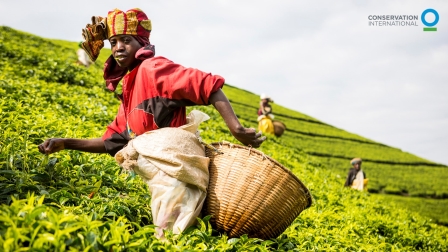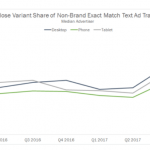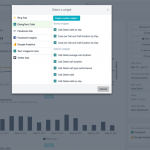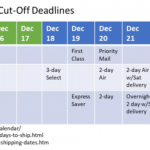A CMO’s View: Conservation International’s influencer marketing gives nature a familiar voice
CMO Meg Goldthwaite shares how her brand builds meaningful relationships with the likes of Harrison Ford, Ed Norton and Reese Witherspoon.

As CMO, Meg Goldthwaite says she considers herself Conservation International’s chief storyteller.
“What’s truly important from a marketing standpoint is that you are able to connect your donors, or in other instances your customers, with the dollars that they spend, and in our case, with the life that’s changed,” says Goldthwaite.
“We do that through stories. We demonstrate how important nature is to livelihoods, and I help bring those stories out that communicate how Conservation International is protecting nature and giving nature a voice.”
In October of 2014, the organization launched the first of its “Nature Is Speaking” video series, a star-studded influencer marketing campaign that includes high-profile celebrities like Harrison Ford, Julia Roberts, Ed Norton, Penélope Cruz and Robert Redford.
“When people hear Julia Roberts as Mother Nature, it goes into their being,” says Goldthwaite.
“They’ve been listening to that incredible voice for such a long time, and it’s had such an emotive effect in movies for years and years — and now, you’re hearing these incredible words coming from Mother Nature through the voice of Julia Roberts. It’s just incredible what it can do for you.”
Leading a team of more than 30 people, Goldthwaite manages all of Conservation International’s communications.
“Our social media, our earned and paid media, our website, as well as our branding, video production, editorial — everything having to do with marketing and communications runs through my team.”
Today, Goldthwaite shares the steps her organization has taken to build influencer relationships with celebrities who not only have a loyal audience, but also a voice that has helped Conservation International elevate its brand and reach its goals.

Meg Goldthwaite
CMO @ Conservation International
Takeaways:
1. Make sure your brand and the influencer have mutual goals, and that the influencer is available and wants to support you.
2. Make sure the influencer you choose has an active voice.
3. Make sure you understand your audience, and know the influencer’s audience. You want an influencer relationship to either take you deeper into an audience you already have, or take you into a new audience.
Amy Gesenhues: How big a role does influencer marketing play in your overall marketing strategy?
Meg Goldthwaite: A big one, particularly in the last couple years since we launched “Nature Is Speaking.”
We’re going to celebrate our 30th birthday in January of 2017, and Conservation International has been doing incredible work all around the world; however, we spend so much time in the mud doing science and conservation that we were not really doing a fantastic job of telling people who we are and exactly what conservation looks like and what it means to protect nature.
A few years ago, everyone sat down and said, “Okay, how do we more clearly connect Conservation International with this notion that we are the ones that are protecting nature for the well-being of people?”
We came up with the concept of “Nature Is Speaking“ and this line that nature doesn’t need people, but people need nature. In order to get that message out, we knew that the best way to do it is to bust into the social conscious[ness] and culture of our world.
The best way to do that is to work with voices that are familiar, and so we came up with our “Nature Is Speaking” Campaign. We decided that we were going to have various aspects of nature talk about what they were feeling — What would the ocean say if the ocean could speak? Or what would Mother Nature or the soil say if they could speak?
We wanted to reach out and grab a familiar voice, and so we did that by having Harrison Ford play the role of the ocean, and Kevin Spacey played a role of the rain forest, and Edward Norton as the soil.
“Nature Is Speaking” very much revolves around this idea of having influencers, because that’s who’s really going to take our message to everyone.
AG: How have you extended the campaign beyond the videos?
MG: We also did two social media campaigns around it. The first one we fondly refer to as the Million Dollar Hashtag. It was partnership that we came up with with HP where they promised that they would give us $1 for every use of the hashtag #NatureIsSpeaking in social media.
When you take that to an influencer like Ian Somerhalder, who has such a passionate group of followers particularly on social media, and he explains every time you use a #NatureIsSpeaking HP is going to give a million dollars to Conservation International, that takes off in a really big way.
Wish @IanSomerhalder happy birthday today + #NatureIsSpeaking & @HP will gift $1 to @ConservationOrg! #HappyBirthdayIanSomerhalder
— Conservation Intl (@ConservationOrg) December 8, 2014
That’s just one way that influencers have been able to lead us to very monetary benefits of monetizing this campaign that ultimately lead to a $1,000,000 from HP. And we were able to hit the hashtag in just six months, which is pretty incredible.
We did something very similar around the climate conference in Paris last year with a hashtag campaign called #INeedNature.
We asked people to take a selfie of themselves in nature and then put it out on social media with the #INeedNature hashtag. Then, you have somebody like Lee Pace, who also has incredible group of people who are following him and who are happy to oblige, post a selfie in nature and all of his fan bases follow.
#INeedNature pic.twitter.com/BeYhFFCkQo
— Lee Pace (@leepace) December 5, 2015
It allows us to get more reach and much broader reach for our messages.
AG: How do you determine who is going to be a strong influencer for your brand?
MG: Part of it is that you need to be opportunistic — Who’s out there that cares about conservation? We look for opportunities and say, “Let’s take a look at people who are living these lives dedicated to conservation, dedicated to nature, or who put an incredible importance on protecting it.”
We’ve looked to people like Edward Norton, and some others, who have done so much work, and then obviously you want to take a look and see what reach they have. You can’t have somebody that’s not going to believe in the message sharing that message.
We see who is out there that has goals that align with ours. Sometimes they come to us, sometimes we go out in search of them. Who’s playing a big role in conservation right now? Leo DiCaprio is an example of someone who is playing a very active role in raising awareness for climate change and doing so much for nature right now. So working with him and getting him to amplify our messages through social media is important to what we do.
We want people who are going to be excited about what we’re doing because those are the people who are going to be able to convey their excitement to their audience — and that’s what becomes infectious and takes the message out.
AG: Once you’ve identified an influencer, can you take me through the process of building that relationship? How does it work from the brand side?
MG: Typically, we have mutual goals, and there is mutual respect. Obviously, when you’re working with someone, particularly a celebrity, they have their own brand, so we’re mindful of following their guidelines, and we ask for them and make sure that we’re being respectful of them. They do the same thing with us, and make sure that we’re fine with what it is that they’re doing.
I’ll go to the example of Edward Norton, simply because that’s an interesting one. I mean, there are times when we will reach out and say, “This is important to us, Liam Neeson, will you be our voice of ice?” And we reached out and asked him, because when we wrote the script for our ice character, we heard Liam Neeson’s voice.
Edward Norton, in this case, he reached out to us because he has a platform that he’s created called CrowdRise — and we’ve worked with Edward — he’s been on our Board of Directors. Edward came to us and said, “I have this cool opportunity with Radiohead and a couple of tickets, and I’d like to take this opportunity to raise some money for conservation, raise some awareness for your work, and thank some fans for loving Edward Norton, for loving Radiohead, and for loving conservation.”
Meet Radiohead backstage with Edward Norton & support Conservation International and Maasai Wilderness Conservation Trust.
Posted by Conservation International on Wednesday, July 13, 2016
He brought that to us. An incredible conservationist who is an influencer, who also has an amazing platform that we can climb onto in terms of CrowdRise — so that was win-win as far as everybody was concerned.
Edward has done many things for us, he is the voice of the Soil for us. He has, when “Nature Is Speaking” first launched, done events with us, and used his social media powers to communicate that message as well. It really is wonderful because we work with him on so many dimensions that makes it even more powerful.
AG: Have you ever had to end a releationship with an influencer, or needed to back-away from an influencer who has shared opinions on a public platform that reflected poorly on your brand?
MG: I am happy to tell you that I don’t have an experience to share where things have gone wrong. Probably, in large measure, because we work with people who are serious about conservation, and so we haven’t been in a situation where we have needed to end a relationship with an influencer.
I mean there are ebbs and flows. There are times when people are in the public eye and are very much raising their voice. Adrian Grenier right now — with his Lonely Whale project — is talking a lot about ocean conservation at the same time we’re talking about ocean conservation. So that’s something that’s flowing right now.
Our work with others — they may be onto other things, or maybe not be very public right now — so things ebb and flow, but we haven’t been in a situation where we have had to control that situation. I’m glad for that, and I hope that it’s because so many people are very, very serious about protecting nature.
AG: Would you agree that being proactive in the vetting process for influencers has helped your brand from suffering relationships gone bad?
MG: Yes, absolutely. For example, we decided that we would work with Reese Witherspoon to be our voice of Home, which is a very key movie for us because we were launching it at the Paris Climate in last December — a massive global moment for us.
We wanted to have a film and a voice to that film that was really going to pull people together with this notion that the planet is our shared home.
We decided we were going to work with Reese Witherspoon on it, and Peter Seligmann, our CEO, and I met with Reese. We had a long conversation with her. We talked about conservation, we talked about the importance of it. She told us her views on it, and why it was so important to her, to her family, to her kids. We were very, very comfortable with that.
It’s a two-way street, the influence-sponsors need to know that you’re going to be careful with their brand and that their relationship with you is not going to affect their ability to be successful. And we do the same thing — so, so much of it is built on mutual respect and having shared goals.
I feel if you focus on that, then you’re not going to end up in a bad place.
AG: I know Dr. M. Sanjayan is an executive VP for Conservation International, its senior scientist. How does his role within the organization play into your brand’s influencer marketing strategy?
MG: He’s my boss, and he’s an incredible person to work with, incredibly inspirational. Frankly, one of the reasons why I decided to come to Conservation International was because he had come here several months earlier, and was such an incredibly brilliant and charismatic leader, both in the science world as a biologist, but then also in the media world as a television presenter.
It’s rare that you see that incredible combination, someone who brightens up a screen and also brightens up your mind, because he’s just so incredibly bright, and so he’s wonderful to work with.
He manages to do it on so many levels — Sanjayan spoke to the partners at Starbucks a couple of years ago, and they loved it. He’s such an incredible speaker and fascinating to listen to, and he has a great social media following in his own right — he’s someone people want to speak with.
He’s been affiliated with incredible projects like the “Years of Living Dangerously” and “EARTH – A New Wild,” and, so by himself, he is a celebrity – but, he also, from a marketing standpoint, has a very keen marketing and communications eye.
He was very much the force behind the creation of “Valen’s Reef,” our virtual reality film, and also was instrumental in a strong launch of “Nature Is Speaking.”
I’m thinking back to one event that we did when we launched “Nature Is Speaking” at a Mashable event at the Social Good Summit. When Sanjayan took the stage with Pete [Cashmore] from Mashable, and Edward Norton, and it was just a force of three of them up there having a conversation about conservation, it was incredibly strong.
He plays both roles, and then he also plays a third role in being our chief scientist, because not only does he lead the marketing and fundraising operations within Conservation International, but he also runs our science and ocean divisions as well. So he can talk on absolutely any level, from media appeals to biodiversity in South Africa.
AG: One last question. What advice would you give to brands considering an influencer marketing campaign?
MG: It’s really important, first of all, to understand who’s already aligned with your goals.
Lee Pace is an excellent example of someone who was very excited about conservation and protecting nature, and so we didn’t have to go to him and say, “Let me tell you about nature, let me tell you about conservation,” because he already knew and he wanted to know more.
So, I would say first, make certain you’re selecting someone who is aligned with your goals, and that’s not difficult to figure out — It’s clear who wants to play a role in conservation. You can look at their social media and what they’re doing in their personal life.
You figure out what it is you want to promote, or from a brand perspective — if you’re Starbucks — you figure out who’s caring about coffee, and then go to that.
That’s the first step. Then, identify how to make it a two-way street with that influencer, so it’s not just, “Hey, could you share our message,” but “What is it that you’re trying to accomplish? Let’s figure out how what you’re trying to accomplish and what we’re trying to accomplish can be the same thing,” making certain that it’s going to be a two-way street.
If they can’t do multiple things for me, is that going to be worth the time investing in that relationship?
I’ll take Lee Pace as another example. He wants to engage with us on multiple levels, which is really important. He’s on one of our boards, he’s on our leadership council, he comes to meetings, and participates in conservation conversations, and makes himself available to us in multiple ways.
It’s really important that you’re not going to get a one-hit wonder, somebody that is going to say, “That’s great — I’ll do that one thing for you,” and then they’re gone.
If you’re going to invest in a relationship, you want to make sure both people are investing, and that they’re available, and that they’re going to be able to do something for you.
Marketing Land – Internet Marketing News, Strategies & Tips
(45)












